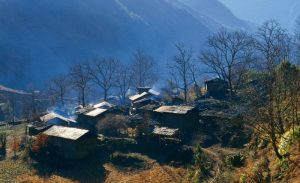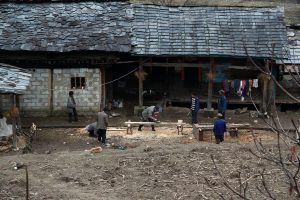Dimaluo Village in Bingzhongluo, Nujiang

Attraction Overview
Dimaluo is a village in Gongshan County located in a side valley of the Nu Jiang Valley in the north-eastern part of Yunnan. It is a small enclave of Tibetan culture in a county that also contains people of Lisu, Nu, and Dulong descent. As the original population of the valley was predominantly Nu, many of the families here are now mixed Nu-Tibetan descent.
Attraction Type: Traditional Village
Chinese Name: 迪麻洛村(Pinyin: Dimaluocun)
Best Time to Visit: October to next April
Open Hours: All Day
Admission Fee: Free
Altitude: 1,815 meters
Location: Gongshan Autonomous County of Dulong Nationality, Nujiang Lisu Autonomous Prefecture, Yunnan
Brief Introduction
Dimaluo is a village in Gongshan County located in a side valley of the Nu Jiang Valley in the north-eastern part of Yunnan, China.The Dimaluo River flows through the village and is a tributary of the nearby Nujiang River. Although “Dimaluo” is a Lisu word meaning “plains”, the village is a small enclave of Tibetan culture in a county that also contains people of Lisu, Nu, and Dulong descent. Tibetans do not actually form a majority of the village’s population, but the dominant language and the public displays of culture (music, dance, and traditional dress) are all Tibetan. As the original population of the valley was predominantly Nu, many of the families here are now mixed Nu-Tibetan descent.
Geography and Climate
Dimaluo is located at an altitude of approximately 2,000 meters above sea level. It is bisected by the Dimaluo River which flows directly into the Nujiang River roughly 10 km downstream from Dimaluo village. The village sits in the Dimaluo River Valley and is surrounded by the steep valley walls. The valley walls reach a height of nearly 4,300 meters.
Dimaluo is located in a subtropical highland climate (Köppen Cwb), and, due to its high altitude, never gets very hot in summer. The rainy season is typically from June through September and receives its first snowfall in early November.

History
The Catholic Tibetans, whose culture is now representative of the village, first came over the mountain passes from Deqin with Jesuit friars who were trying to make their way to Tibet. Missionaries from the Missions É trang è res de Paris first arrived in the Nujiang valley in the 1850s and 60’s. They had been successful in making a number of Nu converts in the Dimaluo area. Because there was no written Nu language, instructions took place in Tibetan, giving rise to Tibetan as a language of high status among converted communities.
Religion
The majority of households in Dimaluo are Catholic. They go to church on Saturday evenings and Sunday mornings. Unlike most Tibetan villages, you will see no prayer flags and stupas here. Instead, there are pictures of Jesus and the Virgin Mary hanging in most households. The low benches in the church are no more than a few inches off the floor, but double as kneeling benches for praying. During Sunday morning services, readings by young boys in Mandarin and Tibetan alternate with singing and chanting as people filter in and out, crossing themselves and ducking their heads at each entrance and exit. The inside of the church is clean, stark, with a greenish hue cast from the walls. Over the exterior of the door, words in Chinese and Tibetan are interspersed with fine paintings of angels and birds. Out of around 3,200 people in all of Dimaluo (including all 12 villages), about 80% are Catholics.

Language
Many of the people in Dimaluo speak Tibetan, Nu, and Lisu. Some can speak Dulong. Most of the younger people also speak Mandarin, with just a tinge of the Gongshan accent. Most of the people in the village have at least three names: a Tibetan one, an English (Catholic) one given to them at birth, and a Chinese one they were given when they started school – as well as whatever nicknames they have acquired along the way.
Recommended Hiking Route
Dimaluo Village(迪麻洛村) – Baihanluo Village(白汉洛村) – Balagong Pass – Qinggong Summer Pasture – Shelalaka Pass(蛇拉腊卡垭口) – Diwazhaduo Pasture(迪瓦扎多牧场) – Gongduola Pass – Cizhong Village
Tours including Dimaluo Village
5 Days Amazing Nujiang Valley and Biluo Moutain Trekking
20 Days Yunnan Three Parallel Rivers Adventure Trekking Tour
39 Days Yunnan 25 Ethnic Minorities Discovery and Photography Tour

 7 Days GolfingTour
7 Days GolfingTour
 8 Days Group Tour
8 Days Group Tour
 8 Days Yunnan Tour
8 Days Yunnan Tour
 7 Days Shangri La Hiking
7 Days Shangri La Hiking
 11 Days Yunnan Tour
11 Days Yunnan Tour
 6 Days Yuanyang Terraces
6 Days Yuanyang Terraces
 11 Days Yunnan Tour
11 Days Yunnan Tour
 8 Days South Yunnan
8 Days South Yunnan
 7 Days Tea Tour
7 Days Tea Tour
 8 Days Muslim Tour
8 Days Muslim Tour
 12 Days Self-Driving
12 Days Self-Driving
 4 Days Haba Climbing
4 Days Haba Climbing
 Tiger Leaping Gorge
Tiger Leaping Gorge
 Stone Forest
Stone Forest
 Yunnan-Tibet
Yunnan-Tibet
 Hani Rice Terraces
Hani Rice Terraces
 Kunming
Kunming
 Lijiang
Lijiang
 Shangri-la
Shangri-la
 Dali
Dali
 XishuangBanna
XishuangBanna
 Honghe
Honghe
 Kunming
Kunming
 Lijiang
Lijiang
 Shangri-la
Shangri-la
 Yuanyang Rice Terraces
Yuanyang Rice Terraces
 Nujiang
Nujiang
 XishuangBanna
XishuangBanna
 Spring City Golf
Spring City Golf
 Snow Mountain Golf
Snow Mountain Golf
 Stone Mountain Golf
Stone Mountain Golf













